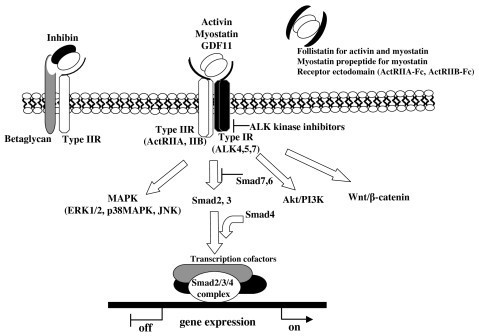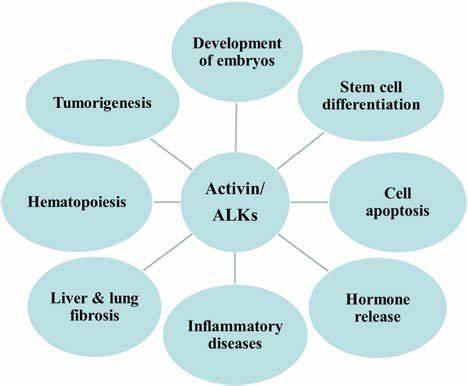Activin Receptor
Related Symbol Search List
Immunology Background
Available Resources for Activin Receptor Research
At Creative BioMart you can find a wide range of products related to activin receptors, including recombinant proteins, protein pre-coupled magnetic beads, cell & tissue lysates, and other key products. In addition, we offer customized services to meet your specific requirements, ensuring you get the product you need.
In addition to our products and services, we offer a wealth of resources for your reference. Our resources cover all aspects of activin receptor, including the involved pathways, protein function, interacting proteins, related articles, research areas, and other relevant topics. These resources will be invaluable to researchers wishing to deepen their understanding of activin receptors and their role in physiological processes.
Our Featured Products
About Activin Receptor
Activin receptors are transmembrane receptors that play a crucial role in mediating the biological effects of the ligands activin, inhibin, and other related proteins. These receptors are part of the transforming growth factor β (TGF-β) superfamily and are involved in a variety of cellular processes, including cell proliferation, differentiation, and apoptosis.
There are two types of activin receptors, known as type I and type II receptors. Type II receptors, such as ActRII and ActRIIB, are responsible for binding to the ligands, while type I receptors, such as ALK4 and ALK7, are involved in signal transduction and activation of downstream pathways.
Activation of activin receptors leads to the phosphorylation of intracellular signaling molecules, such as SMAD proteins, which then translocate to the nucleus to regulate gene expression. Dysregulation of activin receptor signaling has been implicated in various diseases, including cancer, neurodegenerative disorders, and infertility.
Overall, activin receptors play a critical role in cellular growth and development, and understanding their function and regulation is essential for the development of targeted therapies for a range of diseases.
Activation and Signaling Pathways of Activin Receptors
Activation
- Activin receptors are activated through the binding of activin ligands, such as activin A and activin B, to the extracellular domain of type II receptors, primarily ActRIIA and ActRIIB. This ligand-receptor interaction induces the recruitment and phosphorylation of type I receptors, typically ALK4 and ALK7.
Signaling Pathways
- Once activated, the type I receptors phosphorylate downstream intracellular proteins called Smads, specifically Smad2 and Smad3. Phosphorylated Smad2 and Smad3 form complexes with the common mediator, Smad4, and translocate into the nucleus. These Smad complexes act as transcription factors, bind to specific DNA sequences known as Smad-binding elements, and regulate the expression of target genes involved in various cellular processes.
- In addition to the Smad-dependent pathway, activin receptors can also activate non-Smad signaling pathways, such as the mitogen-activated protein kinase (MAPK) pathway and the phosphoinositide 3-kinase (PI3K)/Akt pathway. These pathways can further modulate cellular responses to activin signaling and contribute to the diverse effects of activin in different cellular contexts.
Interactions with Other Signaling Pathways and Molecules
- Activin receptors can interact with other signaling pathways and molecules, leading to crosstalk and modulation of cellular responses. For example, activin receptors can interact with other members of the TGF-β superfamily, such as TGF-β itself and bone morphogenetic proteins (BMPs), sharing common intracellular signaling components.
- Activin signaling can also intersect with other signaling pathways, including the Wnt/β-catenin pathway, Notch pathway, and Hedgehog pathway, among others. These interactions can influence the outcome of cellular responses, leading to synergistic or antagonistic effects on cell behavior and developmental processes.
- Furthermore, activin receptors can interact with various co-receptors and binding proteins that modulate activin ligand availability, receptor affinity, and downstream signaling. Examples of such molecules include follistatin, which binds and sequesters activin ligands, and inhibins, which are antagonists of activin signaling.
The interactions between activin receptors and other signaling pathways and molecules highlight the complexity and versatility of activin signaling in regulating diverse cellular processes and their integration within broader signaling networks. These interactions are crucial for coordinating cellular responses and ensuring proper development, tissue homeostasis, and disease pathogenesis.
 Fig.1 Signal transduction through activin receptors. (Tsuchida, K., et al., 2009)
Fig.1 Signal transduction through activin receptors. (Tsuchida, K., et al., 2009)
Role of Activin Receptors in Development, Growth, and Disease
- Activin receptors play critical roles in various aspects of development, growth, and disease. During embryogenesis, activin signaling is involved in processes such as cell fate determination, mesoderm induction, and organogenesis. It influences the differentiation and patterning of different tissues and organs, including neural tissue, skeletal muscle, and reproductive organs.
- In postnatal life, activin receptors continue to be involved in tissue homeostasis, regeneration, and growth. They play roles in regulating cell proliferation, differentiation, and apoptosis in various tissues, including the reproductive system, skeletal muscle, bone, and immune cells
- Dysregulation of activin signaling and aberrant activation of activin receptors have been implicated in several diseases. Excessive activin signaling has been associated with conditions such as cancer, fibrosis, and inflammatory disorders. On the other hand, reduced activin signaling or mutations in activin receptors have been linked to developmental disorders, reproductive abnormalities, and neurodegenerative diseases.
 Fig.2 Biological functions of activin and activin receptor-like kinases. ALK, activin receptor-like kinase. (Cui X, et al., 2019)
Fig.2 Biological functions of activin and activin receptor-like kinases. ALK, activin receptor-like kinase. (Cui X, et al., 2019)
If you have any questions, requirements, or cooperation intentions, please feel free to contact us. We very much look forward to working with you and helping you achieve research and commercial success.
References:
- Tsuchida, K., Nakatani, M., Hitachi, K. et al. Activin signaling as an emerging target for therapeutic interventions. Cell Commun Signal 7, 15 (2009).
- Cui X, Shang S, Lv X, Zhao J, Qi Y, Liu Z. Perspectives of small molecule inhibitors of activin receptor-like kinase in anti-tumor treatment and stem cell differentiation (Review). Mol Med Rep. 2019;19(6):5053-5062. doi:10.3892/mmr.2019.10209

